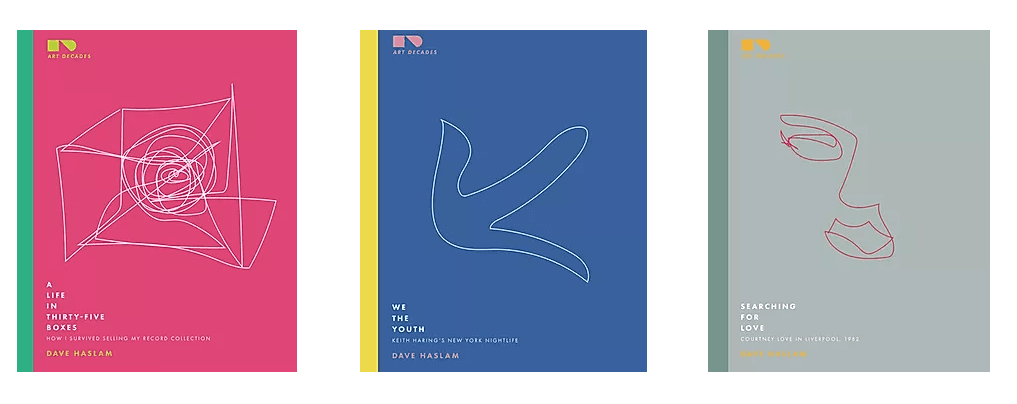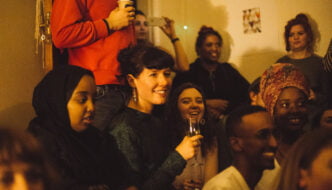
‘Art Decades’, Dave Haslam
Avant-garde art forms, underground music and socio-cultural activism will always be inextricably linked. Dave Haslam, former DJ at the legendary Haçienda club and the author of five best-selling books, navigates these nuances effortlessly in his series of mini books entitled ‘Art Decades’. The series so far includes ‘We the Youth: Keith Haring’s New York Nightlife’, ‘A Life in Thirty-Five Boxes: How I Survived Selling My Record Collection’ and ‘Searching For Love: Courtney Love in Liverpool, 1982’. The series’ sleek and minimalist design by Zoë Mclean befits its unique content, published by independent Manchester-based Confingo Publishing.
In ‘We the Youth’ Haslam pays beautiful homage to the vibrant and exhilarating life of Keith Haring before his premature passing at the age of 31. The book is an evocative excavation of a fascinating, progressive individual who blurred boundaries between high art and popular culture. Haring is placed at the pinnacle of this alternative New York art scene. His lovers, personality and influences are intimately bound through past interviews, personal journals and testimonies from his diverse group of friends, including Grace Jones and housemate Samantha McEwen, who described the book as “a dream”.
In true Haslam style, the musical influences on Haring, such as the rogue, new wave B52s, are well documented, as well as the underground club scene that immersed him. Club 57 is painted as a pivotal hub of collective energy, a place where Haring would simultaneously host exhibitions and dance parties. Haslam simply but effectively states: “Nothing lasts forever: not youth, not life and certainly not nightclubs”. He skilfully balances the hedonism and frivolity of this experimental era with the critical social and cultural devastation caused by gentrification and the AIDS crisis, both of which heavily impacted this thriving community in downtown Manhattan. It is a carefully researched, in-depth tribute to Haring and his passions: art, music, and activism.
‘Searching For Love: Courtney Love in Liverpool, 1982’ tells the saga of brazen and brash, LCD equipped, seventeen-year-old Love’s musical awakening in Liverpool. Again meticulously researched, Haslam unpicks and unravels the barrage of myths told about Love in Liverpool, one being losing her virginity to the sound of Joy Division’s ‘Isolation’. He gives us an exclusive peek into what Love describes as “one of the most important things of [her] existence” whilst also diving deep into the chaotic inner circles of the thriving early 80s north-west scene, encompassing the likes of Probe Records and Echo & The Bunnymen.
During this time Liverpool was facing mass hardship, far from being glamorous. The independent record labels helped to create a voice for the city that was politically being denied. During this formative experience for the soon-to-be rockstar, Love clung to Julian Cope, hung out in Café Tabac, and hoped to slurp up all the culture and cider that Liverpool had to offer. Love is generally seen as in a little bit of a state, but Haslam conveys her youthful fire and fighting desire to succeed in rock and roll. It seems that without the musical magic of Merseyside, Love may never have met Cobain…
‘A Life in Thirty Boxes: How I Survived Selling My Record Collection’ is Haslam’s personal essay exploring our human compulsion to collect, and our emotional attachment to vinyl. He nostalgically traces his own infatuation with collecting records, from saving his pocket money to buy 7” singles, to discovering wonders from around the globe at Eastern Bloc Records in Manchester.
The essay is a moving account of how a series of personal experiences led Haslam to sell his entire record collection to DJ Seth Troxler. He strongly puts forward a case that our attachment to vinyl comes from emotional memories, rather than owning these circular pieces of plastic. For Haslam, these records became “baggage of the past”; as he poignantly states “I was surviving by selling my record collection”. He picks out two singles, as keepsakes for his son and daughter, before boxing up the records and shipping them to Troxler. He takes the view that every generation needs to develop passions and make memories of their own. Vinyl is deeply intimate to the buyer and the fate of a record collection should lie with the collector. But, despite his persuasive case for selling his collection, I still can’t quite get my head around it – perhaps this is due to my personal attachment to my dad’s vinyl.
What excites me is the intergenerational sharing and fusing of past and present, leading to the birth of a new collection, guided slightly by the old. For me, my dad’s collection is an experience of discovery that allows me to plunge into his passions and his previous selves. Each 7” and B-side has inspired conversations we may never have broached if it wasn’t for these circular pieces of plastic as prompts.
“Each record is a tangible token of who we were when we fell in love with that piece of music. The collection, however small and disorganised, represents a personal journey through music, our changing passions, our pleasures, our life.”
A couple of days ago, I was rooting through an old box of 7” singles and came across the golden and gleaming New Order ‘Ceremony’. This was the first time I had heard it played on vinyl, and I couldn’t help but imagine how my dad felt, playing it for the first time, probably the same age as I am now. I proceeded to play it on repeat seven times. Given our personalities, I presume the track projected similar emotions onto us both, though separated by thirty years. I’m not sure I could forgive him if he sold his record collection…
It is fitting that ‘A Life in Thirty-Five Boxes’ was the first mini-book published in a series that is itself, likely to become highly collectable. Each mini-book is highly evocative and original in nature, and magnificently explores the perpetual adoration of art, music and literature rooted in cities, recent history and lived experience. The next in the series is set to be based upon Sylvia Plath and due to be published at the end of this year.
The first three books of the series are available to purchase separately, or together in a special lockdown offer – take a look here.
Filed under: Written & Spoken Word
Tagged with: Art Decades, art. record collection, book, courtney love, Dave Haslam, keith harring, music, review, vinyl



Comments